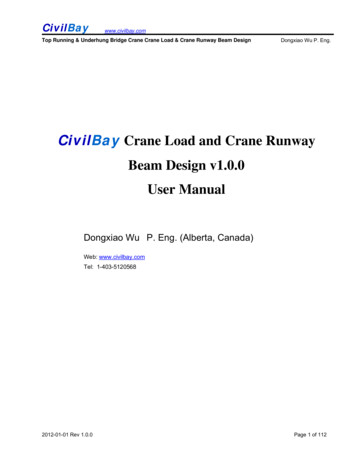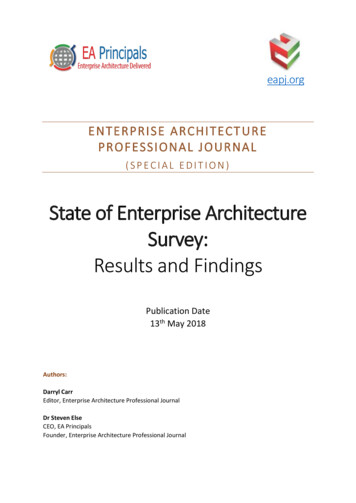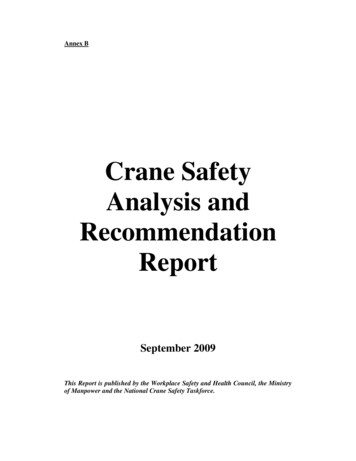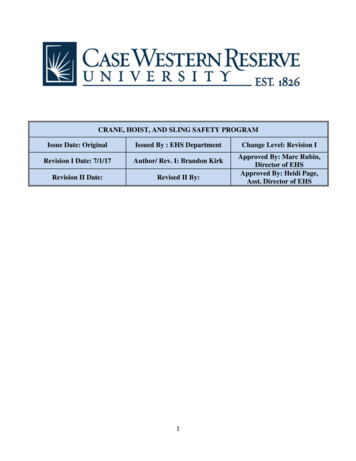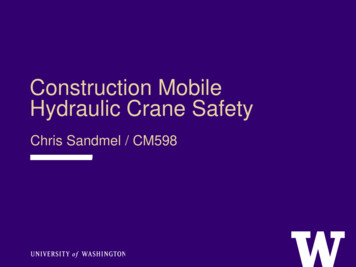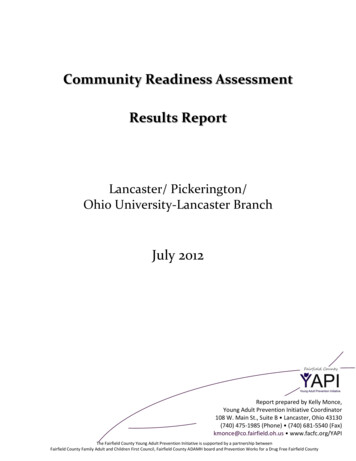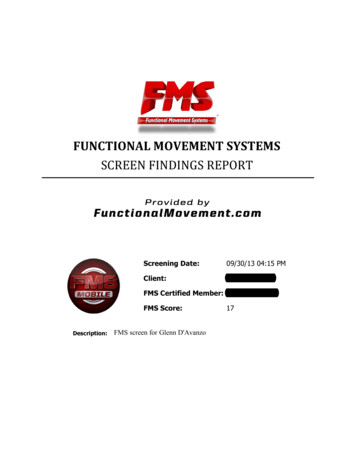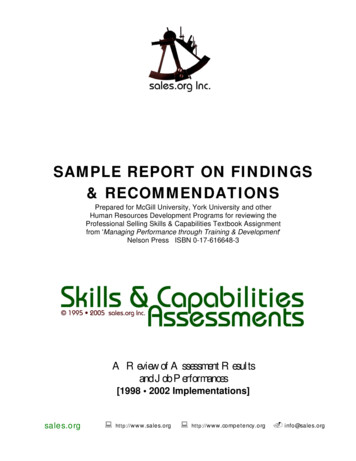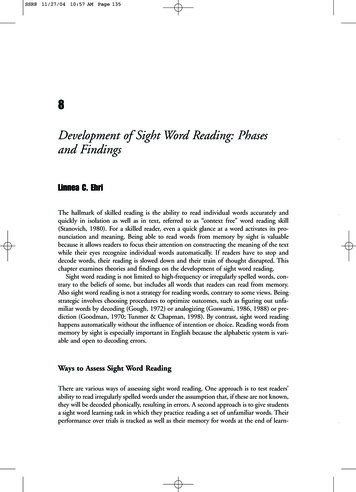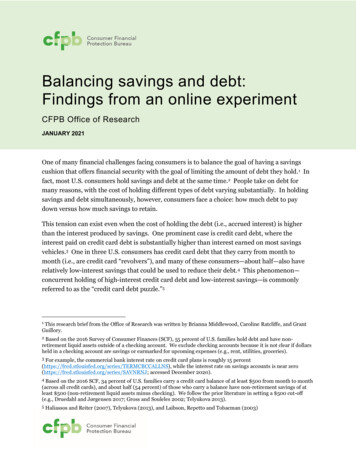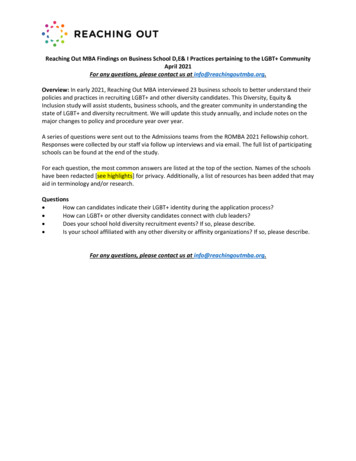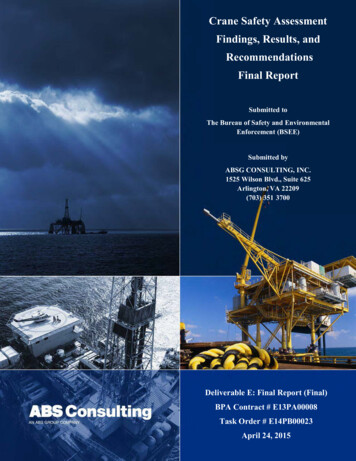
Transcription
Crane Safety AssessmentFindings, Results, andRecommendationsFinal ReportSubmitted toThe Bureau of Safety and EnvironmentalEnforcement (BSEE)Submitted byABSG CONSULTING, INC.1525 Wilson Blvd., Suite 625Arlington, VA 22209(703) 351-3700Deliverable E: Final Report (Final)BPA Contract # E13PA00008Task Order # E14PB00023April 24, 2015
THIS PAGE INTENTIONALLY LEFT BLANK
Executive SummaryThe Bureau of Safety and Environmental Enforcement (BSEE) works to promote safety, protect theenvironment, and conserve natural resources on the Outer Continental Shelf (OCS) through vigorousregulatory oversight and enforcement. BSEE is responsible for enforcing the regulations found at 30 CFR250.108 for cranes and material handling equipment installed on fixed platforms on the OCS. In additionto the 30 CFR 250 crane regulations, BSEE requires lessees and operators to comply with variousindustry standards incorporated by reference into regulation. Conversely, the United States Coast Guard(USCG) is responsible for safety of life on floating facilities operating on the OCS. The USCG crane andmaterial handling certification and inspection strategy is promulgated in 46 C.F.R. §107.258 and 259.Crane inspections may be conducted by a USCG marine inspector or by one of two authorized thirdparty inspectors.On April 25, 2014, BSEE initiated the Crane Safety Assessment. The study involved analysis of cranes andmaterial handling equipment operating on the OCS, analysis of BSEE lifting Potential Incidents ofNoncompliance (PINCs) and incidents, review of industry standards and practices, and recommendationsfor changes to lifting regulation. The goal of this study was to develop an inspection methodology thatmay be used by BSEE and USCG personnel in performing an assessment in regards to the safety ofcranes and material handling equipment.The team began by researching the population and attributes of cranes and material handlingequipment operating on the OCS. Crane operators and service providers were consulted to provideinformation on the age, type, and population of cranes operating on the OCS. BSEE and USCG providedGovernment Furnished Information (GFI) such as lifting PINCS, records of OCS lifting incidents, andrecords of crane populations on the OCS to inform the study. Following the collection of information,the study team performed a statistical analysis on the population of cranes and material handlingequipment operating on the OCS. The incident data supplied by BSEE through GFI was analyzed toidentify failure event data, trends and key issues that could be addressed in the development of animproved offshore crane and material handling equipment inspection program. The study teamreviewed the lifting PINCs and provided recommendations for improvement and consideration. Liftingstandards, inspection methodologies and strategies were analyzed to identify best practices and provide̤ζΨ̍̍̕ζ̎βΚ̲ϵ̨̎̕ π̤̕ EEϳ̨ Ψ̨̎̕ϵβζ̤Κ̲ϵ̎̕ ϵ̎ ̲ϲζ ϵ̎Ψ̡̤̤̕̕Κ̲ϵ̎̕ ̕π ̲ϲζ̨ζ practices into an inspectionstrategy. BSEE stakeholders were consulted and engaged throughout the analysis phase of the study andprovided interim feedback on the analysis results. The study team evaluated the findings of the incidentanalysis and applied their understanding of lifting standards and methodologies to develop interimrecommendations. The USCG BSEE Memorandum of Understanding/Memorandum of Agreement (MOUMOA) was reviewed to inform the study of the responsibility each agency shared in the oversight oflifting equipment on the OCS. BSEE stakeholders were consulted to provide feedback on the interimrecommendations drafted by the study team.Based on the information gathered and analysis conducted it is recommended that the future inspectionstrategy move away from a ̡̤ζ̨Ψ̤ϵ̡̲ϵ͘ζ ̍ζ̲ϲ̕β̇̕̕Ϩ͟ϭ EEϳ̨ philosophy of strict regulatory compliance,and toward ensuring that operators create and comply with a robust Safety and EnvironmentalManagement System (SEMS) tailored for their facility.Crane Safety Assessmenti Page
The following recommendations are outlined in the report to produce a robust crane and materialhandling inspection program for offshore facilities which harmonizes with 30 C.F.R §250.108 and 30C.F.R. §250.1913, et seq. and with the intentions of 46 C.F.R. §107.258 and 259: Create database of offshore facilities having cranes subject to API Spec 2D, API RP 2D, andmaterial handling equipment with capacities greater than 5 short tons subject to ASME B30.2.Amend regulation 30 C.F.R. §250.108 for pedestal, overhead bridge, and gantry cranes.Amend regulation 30 C.F.R. §250.108 for material handling.Amend regulation 30 C.F.R. §250.198 to incorporate applicable ASME B30 series standards.Amend PINCs to harmonize with the requirements of 30 C.F.R. §250.1900.Train BSEE inspectors to become qualified crane and rigging inspectors as promulgated by APIRP 2D and ASME B30 series standards, or audit crane inspection records performed by thirdparty qualified inspectors similar to the strategy adopted by the USCG in 46 C.F.R. §107.259.Require drilling systems used on mobile offshore drilling units (MODUs) to be certified drillingsystems (CDS) and inspected by the marine classification society that issued the CDS certificate.Develop a formal training qualification program for BSEE inspectors in mechanical and electrohydraulic equipment fundamentals, hazard identification for machine safety.Inspect or audit third-party inspections to ensure that the cranes and material handlingequipment are designed, maintained, and operated in accordance with the standardspromulgated by marine classification societies, API, or ASME as regulations promulgated by 30C.F.R. 250.108 and 30 C.F.R. 250.1913 (d);The following recommendations for changes to 30 CFR 250.108 (a-e) are shown in red and proposed toimprove worker safety while operating cranes installed on fixed OCS facilities.§250.108 What requirements must I follow for cranes and other material-handling equipment?(a) All pedestal cranes installed on fixed platforms must be operated in accordance withAmerican Petroleum Institute's Recommended Practice for Operation and Maintenance ofOffshore Cranes, API RP 2D (as incorporated by reference in § 250.198).(b) All cranes installed on fixed platforms must be equipped with a functional anti-two blockdevice.(c) If a fixed platform is installed after March 17, 2003, all pedestal cranes on the platform mustmeet the requirements of American Petroleum Institute Specification for Offshore PedestalMounted Cranes, API Spec 2C (as incorporated by reference in §250.198).(d) All pedestal cranes manufactured after March 17, 2003, and installed on a fixed platform,must meet the requirements of API Spec 2C.(e) All overhead bridge cranes manufactured after 1 January 2016 and installed on a fixedplatform must meet the requirements of CMMA Specification No. 70 ̌ Specifications for ElectricOverhead Travelling Cranes (as incorporated by reference in §250.198).(f) All overhead bridge cranes installed on fixed platforms must be operated in accordance withthe American Society of Mechanical Engineers (ASME) B30.2, Safety Standard for Overhead Bridgeand Gantry Cranes (Top Running Bridge, Single or Multiple Girder, Top Running Trolley Hoist) orASME B30.17 Safety Standard for Overhead Bridge and Gantry Cranes (Top Running Bridge, SingleGirder, Underhung Hoist), as applicable to the type of crane, (as incorporated by reference in§250.198). Required frequent and periodic inspections (other than daily or operationalCrane Safety Assessmentii Page
inspections) of overhead bridge cranes shall be performed by a qualified crane inspectordesignated by the crane manufacturer or certified in accordance with the requirements of theNational Commission for the Certification of Crane Operators (NCCCO).(g) All operators of overhead bridge cranes greater than 5 tons must be certified in accordancewith the requirements of the National Commission for the Certification of Crane Operators(NCCCO). Rigging of loads greater than 5 tons shall be conducted by personnel certified inaccordance with API RP 2D or certified in accordance with the NCCCO requirements for Rigger Ifor loads up to 15 tons and Rigger II for loads over 15 tons.(h) All crane owners or operators on fixed platforms must have a crane operations safety policythat differentiates between routine, critical and engineered lifts. Routine lifts are those notdesignated as critical or engineered lifts. Critical lifts are those where the failure or loss of loadcontrol could result in loss of life, major structural damage to facilities or equipment, or largeenvironmental release. Some factors, but not all factors, that may be used to determine a criticallift are: When a load is lifted over or near operating equipment or safety areas designated by adropped object study; When two or more pieces of lifting equipment are required to work in unison, includingtrolleys installed on the same bridge; When special lifting equipment such as non-standard crane configurations or purposebuilt, one-off lifting appurtenances will be used; The weight of the load exceeds set limits such as 20 tons; ϼϲζ ͙ζϵϨϲ̲ ̕π ̲ϲζ ̇̕Κβ ζ͞Ψζζβ̨ ϳϱ ̡ζ̤Ψζ̲̎ ̕π ̲ϲζ Ψ̤Κ̎ζϳ̨ ̤Κ̲ζβ ΨΚ̡ΚΨϵ̲͟Ϯ ̤̕ When making personnel transfers.Engineered lifts are those that exceed the rated capacity of the crane at the required liftingangle (not to include load testing requirements in API Spec 2C). Engineered lifts are soexceptional that there shall be increased inspection requirements to be met prior tooperation. For engineered lifts, the crane shall be inspected by the crane manufacturer or aqualified third-party inspector in accordance with API Spec 2D annual inspectionrequirements not more than two days prior to the lift. Any deterioration or defects found bythat shall be considered in design calculations to support the lift. The crane shall also beinspected by the crane manufacturer or a qualified third-party in accordance with annualinspection requirements, including and non-destructive testing required by the manufacturer,after the engineered lift is completed and prior to release for use in normal operations. Arecord of the engineered lift, including supporting calculations, inspections, weights, and alldistances moved, shall maintained in accordance with (i) (2) below.(i) You must maintain records specific to a crane or the operation of a crane installed on an OCSfixed platform, as follows:(1) Retain all design and construction records, including installation records for any anti-twoblock safety devices, for the life of the crane. The records must be kept at the OCS fixedplatform.(2) Retain all inspection, testing, and maintenance records of cranes for at least 4 years. Therecords must be kept at the OCS fixed platform.(3) Retain the qualification records of the crane operator and all rigger personnel for at least4 years. The records must be kept at the OCS fixed platform.Crane Safety Assessmentiii Page
The following recommendations for changes to 30 CFR 250.108 (f) are shown in red and proposed toimprove worker safety while operating material handling equipment installed on fixed OCS facilities.§250.108 What requirements must I follow for cranes and other material-handling equipment?(j) You must operate and maintain all other material-handling equipment in a manner thatensures safe operations and prevents pollution.(1) All winches, including, but not limited to, wireline winches, pneumatic and hydraulic linetuggers, electric, pneumatic and hydraulic planetary gear hoists and winches,electromechanical and umbilical winches, man-riding winches, or any other power-drivendrum devices shall be designed, operated and maintained in accordance with ASME B30.7,Winches (as incorporated by reference in §250.198).(2) All slings shall be operated and maintained in accordance with ASME B30.9, Slings, whichis incorporated by reference in API RP 2D Section 5.2.1 (as incorporated by reference in§250.198).(3) All hooks shall be operated and maintained in accordance with ASME B30.10, Hooks (asincorporated by reference in §250.198).(4) All monorails and underhung cranes shall be operated and maintained in accordance withASME B30.11, Monorails and Underhung Cranes (as incorporated by reference in §250.198).(5) All overhead hoists shall be operated and maintained in accordance with ASME B30.16,Overhead Hoists (as incorporated by reference in §250.198).(6) All below-the-hook lifting devices, including, but not limited to, structural, mechanical,vacuum, close-proximity lifting magnets, plate clamps, or any other device or appurtenanceused for attaching a load to a hoist, shall be operated and maintained in accordance withASME B30.20, Below-the-Hook Lifting Devices (as incorporated by reference in §250.198).Moreover, all below̌the-hook lifting devices, including, but not limited to, spreader bars andframes, pad eyes, attachment points, and all other lifting appurtenances shall be designed inaccordance with ASME BHT-1, Below-the-Hook Lifting Devices (as incorporated by referencein §250.198).(7) All ratchet and pawl and friction brake type lever chain, rope, and web strap hoists (comea-long) used for lifting, pulling, and tensioning applications shall be operated and maintainedin accordance with ASME B30.21, Lever Hoists (as incorporated by reference in §250.198).(8) All detachable rigging hardware used for load-handling activities, including but not limitedto, shackles, links, rings, swivels, turnbuckles, eyebolts, hoist rings, wire rope clips, wedgesockets, rigging blocks, and load-indicating devices, shall be operated and maintained inaccordance with ASME B30.26, Rigging Hardware (as incorporated by reference in §250.198).(9) All loads suspended from rotorcraft-helicopters shall be conducted in accordance withFederal Air Regulation 14 C.F.R. Part 133 and ASME B30.12, Handling Loads Suspended fromRotorcraft (as incorporated by reference in §250.198). Personnel rigging
ASME B30.17 Safety Standard for Overhead Bridge and Gantry Cranes (Top Running Bridge, Single Girder, Underhung Hoist), as applicable to the type of crane, (as incorporated by reference in §250.198). Required frequent and periodic inspections (other than daily or operational Crane Safety Assessment ii Page . inspec tions) of overhead bridge cranes shall be performed by a qualified crane .
